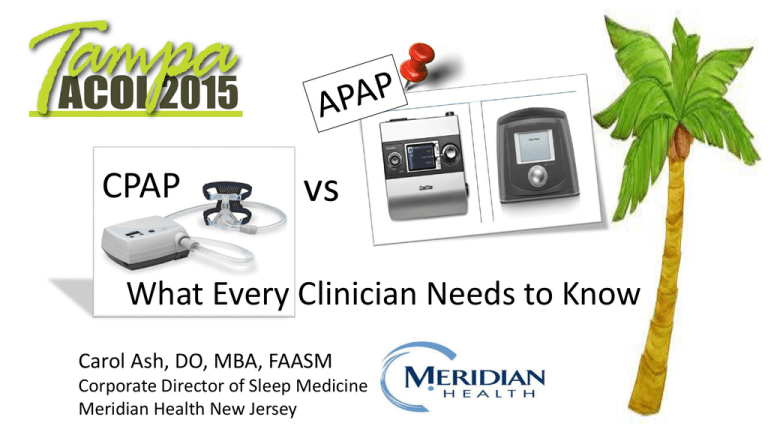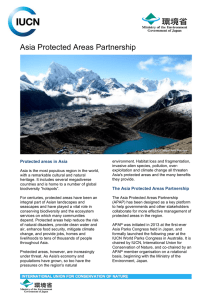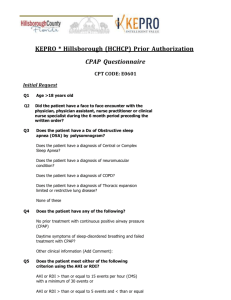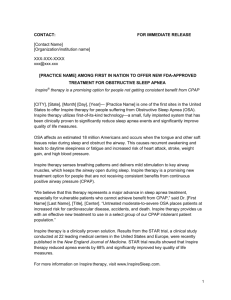APAP vs. CPAP: What Every Clinician Needs to Know
advertisement

CPAP vs What Every Clinician Needs to Know Carol Ash, DO, MBA, FAASM Corporate Director of Sleep Medicine Meridian Health New Jersey CPAP vs APAP • What are the different device options • Understand the operational differences between the two modalities • Separate the myth from the reality • What factors to consider when deciding • Understand unique APAP algorithms for identifying and responding to respiratory events • What the studies recommend • What is the future direction History Positive Airway Pressure (PAP) Devices • Introduced in 1953 by Dr. Bjorn Ibsen, an anesthesiologist during Copenhagen’s polio epidemic, which saw the birth of intensive care • 1981 Dr. Colin Sullivan introduces the noninvasive application of positive airway pressure to treat obstructive sleep apnea (OSA) with the nifty invention of a reversed vacuum machine Dr. Bjorn Ibsen Dr. Colin Sullivan What’s In A Name? • PAP – Positive Airway Pressure • CPAP – Continuous Airway Pressure • Bi-level (BIPAP) • APAP - Auto-titrating PAP (auto-PAP) • ASV - Adaptive Servo-Ventilation PAP Insurance CPAP will be covered for adults with sleep-disordered breathing if: • AHI (or RDI) > 15 OR • AHI (or RDI) > 5 with (“mild, symptomatic”) • Hypertension • Stroke • Sleepiness • Ischemic heart disease • Insomnia • Mood disorders Physiology of PAP • Works to splint the airway open and prevent the collapse of the upper airway • Greater end-expiratory lung volume and increase in oxygen stores • Increased tracheal traction to improve upper airway patency • Lower cardiac after- load and consequent increase in cardiac output • Decrease venous return • Cost-effective and one least toxic forms of medical therapy Negative Consequences PAP • Increase abdominal muscle effort • Provoke anxiety • Cause central apneas by destabilizing breathing • May eliminate CO2 and reduce arterial PCO2 below the apnea threshold • Ventilatory instability characterized by central apneas and periodic breathing. • Mask interface-related skin changes (abrasions, pressure sores, contact dermatitis) • Aerophagia, sinus pain, oral/nasal dryness, tooth decay CPAP vs APAP • CPAP continuous pressure set during titration during in house sleep study or best guess standard treatment OSA • APAP devices change the treatment pressure based on feedback from various patient measures such as airflow, pressure fluctuations, or measures of airway resistance CPAP • Constant between inspiration and expiration • Achieved by a servo-controlled air compressor maintains the airway pressure as closely to the prescribed pressure despite the pull (inspiration) and push (exhalation) • Within an FDA-specified pressure range (for example, ± 1.5 cm H2O of the set pressure) as a quality-assurance measure • Error range is generally greater with larger tidal volume (VT) or inspiratory effort from patient, faster respiratory rate, and at higher RX set pressure • Allows response to changes in the airway pressure Auto-titrating PAP (APAP, auto-PAP) • Built in microprocessors detect and treat OSA • Self-adjusting, automatic, auto-adjusting, smart CPAP and autotitrating PAP (auto-PAP). • Purposes: • Alternative to in-laboratory manual titration • Achieve lower mean pressures, promote adherence • Allows PAP changes in response to changes in: • Severity of OSA , weight, sleep state, body position, alcohol use • Expanded to detecting SDB, treating central apneas, and correcting hypoventilation APAP pressure changes based on a patient’s needs at a specific time CPAP pressure is maintained at a constant, generally based on a patient’s In-lab titration APAP • Aid in the pressure titration process • Address possible changes in pressure requirements throughout a given night and from night to night • Aid in treatment of OSA when attended CPAP titration has not or cannot be accomplished • Improve patient comfort AASM Current APAP Recommendations • Not recommended to: • Diagnose OSA • Facilitate split night titration (certain devices can be used during attended) • Treat: • CHF • Significant lung disease (COPD) • Nocturnal arterial oxyhemoglobin desaturation due to conditions other than OSA (e.g. OHS) • Patients who do not snore (includes post palate surgery) • Central sleep apnea syndromes APAP Device Technology • First generation sensors merely measured pressure vibrations that were caused by snoring • Next generation able to sense flow-based changes (apnea, hypopnea, or inspiratory flow limitation) based upon the inspiratory flow contour (ie, flattening of the inspiratory flow waveform) Newer Generation Devices • Can differentiate central from obstructive apneas • Uses forced oscillation technique / measures compliance changes • Identify Cheyne-Stokes respiration - detects variation peak flow • Identify hypoventilation – measures VT or V̇E using calibrated flow sensors • Compensates for air leaks - using sophisticated flow-based algorithms • Measure upper and lower airway resistance - using forced oscillation techniques APAP Titration for Moderate to Severe OSA • Can be used to identify a single CPAP pressure • Self-adjusting mode for unattended titration and treatment without comorbidities (CHF, COPD, central sleep apnea syndromes, or hypoventilation syndromes) • When used in titration to set fixed CPAP or being treated with APAP must have close clinical follow-up for effectiveness and safety • Symptoms remain - Reevaluate, Standard attended CPAP titration if symptoms do not resolve or APAP lacks efficacy APAP • Intended to be long-term solutions • Is designed to adjust with patients as their condition and physiology fluctuate. • APAP adjusts proactively verses reactively • Auto Set responds to three separate parameters, based on the degree of airway blockage: inspiratory flow limitation, snore, and apnea. Bench Studies & RCTs • Responses of devices from different manufacturers are quite varied • Air leak affected the performance • Some devices were more resilient • Implications of the effects of air leak • RCT avoided comorbid conditions CPAP APAP • Equivalent Control of AHI • At a lower mean pressure • Improving sleep stage distribution and providing comparable improvements in daytime sleepiness • Patients clear preference toward APAP devices and demonstrated marginally improved compliance Coughlin CPAP APAP • Both require follow-up with patients to address issues like mask fit, compliance, and humidity • Clinically validated algorithms to ensure adequate treatment • Flow limitation is a precursor to other more severe sleep-disordered breathing events. An AutoCPAP needs to be able to respond to these flow-limited events in a timely manner to ensure that the more severe sleep-disordered breathing events (apnea and hypopnea) are minimized.” • Now differentiation between APAP solutions for OSA vs CSA CPAP APAP • Sleepiness • Twenty-four trials that included over 1,000 patients provided evidence that APAP reduces sleepiness as measured by ESS by approximately 0.5 points more than fixed CPAP. For compliance, there was a statistically significant difference of 11 minutes per night also favoring APAP compared to fixed CPAP. Recommendations • If patients are carefully selected, auto-PAP-derived optimal CPAP pressure compares favorably to PSG-derived CPAP determinations • Exclude comorbidities (CHF, COPD, CSA, hypoventilation syndromes) from such treatment strategies • Auto-PAP therapy may provide cost savings • Formal cost-effectiveness studies need to be performed with RCTs or across healthcare system databases. • Comparative-effectiveness of auto-PAP and PSG-based management strategies requires further study. Adaptive Servo-Ventilation (ASV) for CSAS • Practice Parameter 2012 Standard: ASV targeted to normalize the AHI is indicated for the treatment of CSAS related to CHF • Field Safety Notice issued by ResMed May 2015 • AASM advised physicians to stop prescribing ASV • To treat central sleep apnea • Symptomatic heart failure with LVEF <45%. Adaptive Servo-Ventilation (ASV) for CSAS FMCSA • Gives little guidance to Medical Examiner • HST to APAP acceptable for treatment, and compliance monitoring • Needs to meet EBM for clinical quality and safety What Is Ahead? • Smaller devices • Convenient battery backup work on one charge for days • Smaller lighter humidifiers • Incorporation of a technology that doesn’t require daily patientinitiated water changes • Easier ability to clean, sterilize, and maintain the device accordingly • Routine sleep screenings as a preventative therapy • Smarter algorithms and sensor features • The “on button” - care delivery is changing for everyone Sleep Health Prevention • Conclusion… EBM – Go by the book, rest assured. Questions?



